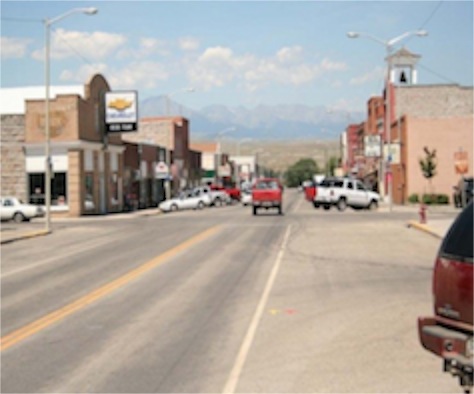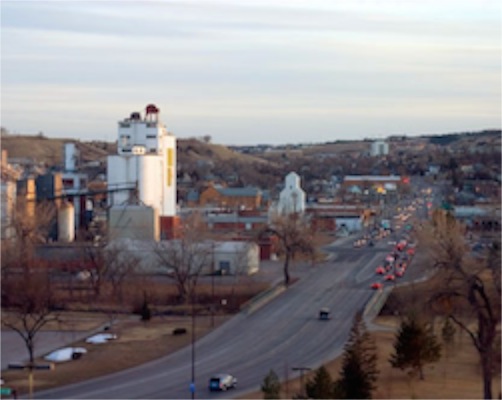
I grew up in Big Timber, Montana. The local story, which I think is correct, is that on the return from their epic journey to the west coast Lewis and Clark split up near the headwaters of the Missouri. Lewis and his followed the Missouri, wanting to explore the Marias River as a possible path to the West. Clark and his contingent headed overland crossing near the Bozeman pass to the Yellowstone River Valley. About thirty miles downstream from where they got to the Yellowstone they finally found cottonwood trees big enough to make dugout boats. From there on the return journey was a float down the river. The Clark contingent arrived at the rendezvous point, where the Yellowstone flows into the Missouri far in advance of Lewis’ group. They almost gave up waiting and were preparing to leave for Missouri when Lewis finally arrived. At any rate, the place where they found the trees big enough to make dugout boats was called Big Timber and the name stuck. Not so clear is the origin of the name of the Crazy Mountains north of town. The most common story told in my town is that a family was heading westward when they fell among Crow raiders in the area. All were killed but a woman, who subsequently escaped into the mountains. Driven by fear and grief she “went crazy” and the area became known as the Crazy Woman Mountains, which eventually was shortened to the Crazies. There are other stories, less plausible. No one seems to know for sure how the name came to be. It has, however stuck. Because the group of mountains stands off by themselves a bit to the east of the main peaks of the Rockies, some people say that they are so called because the middle of the wheat fields is a crazy place to put a bunch of mountains. They aren’t however, the only island ranges in Montana. The Big Belts, Little Belts, Big Snowys, Little Snowys, Hiwoods, Castles and Bulls are all mountain ranges that stand off by themselves to the east of the Rockies in Montana.
Other place names in the area seem to make sense. Froze to Death Creek and Dead Horse Creek need no explanation. Neither does the Boulder River, though there are enough rivers that roll around their boulders at high water that Montana has at least two that share the name – far less than the number of Green Lakes, which might be a bit less than the number of Blue Lakes.

The names we have given to cities and towns seem to be a bit random. I went to college in Billings, Montana, which is not named because it received top billings from the critics, but rather has the name of Frederick K. Billings, president of the Northern Pacific Railroad. After Billings we moved to Chicago, which is kept its name from the Miami and Illinois language. I guess that translating it into English didn’t sound as romantic. The name means “skunk.” I suppose no one wanted to live in Skunk. In defense of the city, the same word was also used to describe an edible plant that grew near the river that is also named Chicago. Maybe it is the place where you can harvest the leeks. Other tribes called them skunk plant. The Menomini called the plant pikwute sikakushia (skunk plant). I think that a more literal translation of shikako would be skunk place, which leaves it open to interpretation whether it refers to the plant or the animal. Having moved from the Big Sky country to the city, I did notice that Chicago has a distinctive odor.
Then we moved to Hettinger, named after a lesser railroad employee and from their to another tree town. Boise is said to have gotten its name from the French trappers who exclaimed, “Les Bois! Les Bois!” when they saw the trees alongside the river. Presumably they approached from the desert to the south rather than the mountains to the north of town. The trees aren’t all that spectacular, but if you spend enough time in the desert any tree is worthy of note.

Now we live in Rapid City. It was originally named Hay Camp, but that name didn’t seem to be right once the town started to grow. They adopted the name from Rapid Creek, which indeed is rapid as it flows out of the hills. No mention of the speed of the city was intended, but it has experienced a few booms of rapid growth. We’ve been using the name for so long that it works for us. The second half of the name, “city,” is open to debate. The folks in Chicago and New York wouldn’t recognize our town as a city, but we’re big stuff in our area. You have to go over 300 miles in any direction to find a town that is bigger. We’ll keep the name “city” thank you very much.

In that we’re lucky. The name city doesn’t always work, especially when used in mining country, which is subject to boom and bust. Silver City, South Dakota is officially a ghost town, though it does have a number of very nice vacation cabins and, I think, a few folk who stay there year around. It doesn’t rate an official number in the census; rather the folks who live there are incorporated into “rural Pennington County.” Silver City, Mississippi has an official population of 336. Silver City Montana has 140, if you speak of the town now officially known as Silver Gate. The old Silver City on the other side of the Slew Creek divide has no residents these days. Silver City, Idaho and Silver City California are also officially designated ghost towns with a population of 0. But not all Silver Cities lack a city. Silver City New Mexico has 10,545 residents. New Mexico isn’t known for big cities, but Albuquerque has more than a half million residents, most of whom don’t consider a town of 10,000 to be a “city.”
Speaking of place names, Albuquerque is a quirky name . . .
Copyright © 2013 by Ted Huffman. I wrote this. If you want to copy it, please ask for permission. There is a contact me button at the bottom of this page. If you want to share my blog a friend, please direct your friend to my web site.



